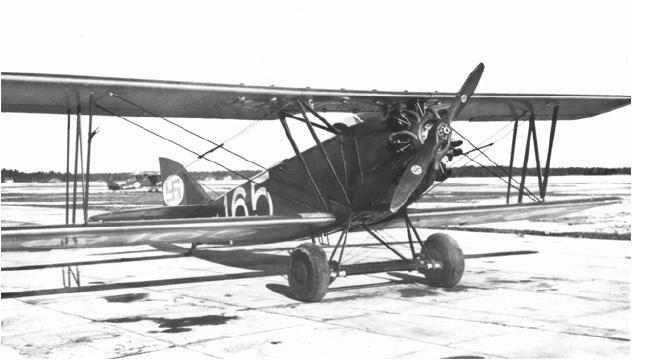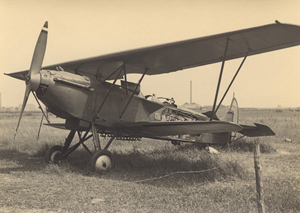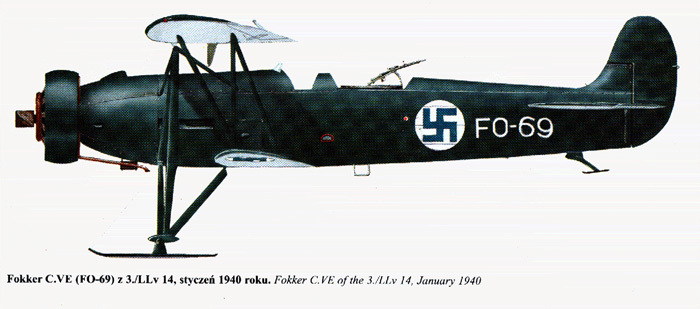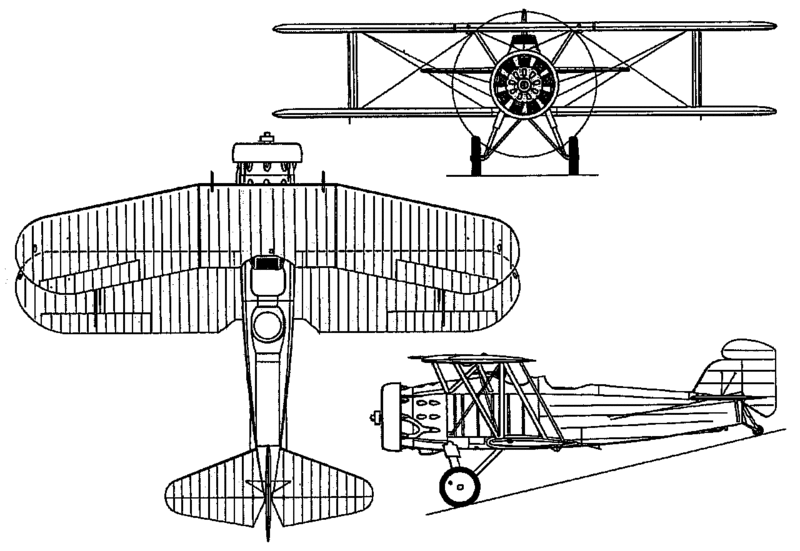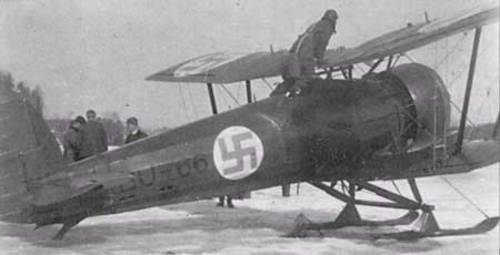The outcome of the 1931 Military Review for the Ilmavoimat was both extremely positive in terms of increased budgeting, and supportive of Somersalo’s views as to the future path the Ilmavoimat should take. Immediate measures that the Ilmavoimat took in 1931 were to order additional aircraft of types already in service while working to plan an immediate acquisition program for the 1932 financial year. That aside, the major planned emphasis was put a detailed five year plan for the continued strengthening of the Ilmavoimat together with the necessary steps towards putting in place the needed unit organisation together with the physical infrastructure. Now given a free rein, promoted and while answerable to the military command, with unfettered access to Mannerheim (which he rarely used), Somersalo was also able to move ahead with the development of the Ilmavoimat’s strategic and tactical doctrine development as he saw necessary and in this he had the assistance of some highly capable subordinates (more on these and the development of the Ilmavoimat’s strategic and tactical doctrine in a subsequent post).
We have already reviewed the Ilmavoimat and Valtion Lentokonetehdas’s purchasing and construction program through the 1920’s in detail. Moving ahead, we will now review the Ilmavoimat’s purchase program on a year by year basis through to the Munich Crisis of late 1938, where we will pause and look at other aspects of Finland’s military defence and foreign policy.
As of the end of 1930, immediately prior to the 1931 Military Review, the Ilmavoimat consisted of the following aircraft:
Ilmavoimat Primary Trainers – as of 1930
64 Caudron C.60s, purchased 1923 (Retired in 1936)
6 Morane-Saulnier MS50.C, in-service 1925 (Retired in 1939)
33 VL Sääski I, II and IIA, in-service 1928 (Retired in 1945)
18 De Havilland DH60 Moth, in-service 1929 (Retired in 1944)
75 Letov S.218.A Smolik, in-service 1930 (Retired in 1945)
Ilmavoimat Fighters – as of 1930
19 Gourdou-Leseurre GL-22, in-service 1923 (Retired in 1931)
15 Martinsyde F4 Buzzard, in-service 1923 (Retired in 1939)
12 Koolhoven F.K.31, in-service 1926 (Retired in 1931)
40 Haukka II, in-service 1927 (Retired in 1944)
Ilmavoimat Ground Attack / Army Liaison – as of 1930
6 Junkers J1, in-service 1919 (Retired in 1932)
1 Fokker CV, in-service 1927 (Retired in 1945)
8 Aero A-11, in-service 1927 (Retired in 1939)
16 Aero A-32, in-service 1929 (Retired in 1944)
Ilmavoimat Transport Aircraft as of 1930
10 Junkers W.34, in-service 1930 (Retired in 1944)
Ilmavoimat Maritime Patrol Aircraft as of 1930
120 VL A.22 Hansa, in-service 1922 (Retired in 1936)
40 Blackburn Ripon IIF, in-service 1929 (Retired in 1944)
As we can see, with some 196 training aircraft, 86 Fighters, 31 Army Liaison/Light Bombers, 10 Transports and 147 odd maritime aircraft, the Ilmavoimat of 1930 was a reasonable size, albeit with a large number of aircraft that were, by 1930, outdated. It was from this foundation that the Commanding Officer of the Ilamvoimat, Aarne Somersalo, would go on through the decade of the 1930’s to build what was the most combat capable and effective air force of the Second World War, with an unrivaled kill ratio.
In 1931, orders for the following aircraft had been placed and these were in the process of being constructed:
Ilmavoimat Blackburn Ripon – 1st ordered 1927 (40 delivered between 1929 and 1933)
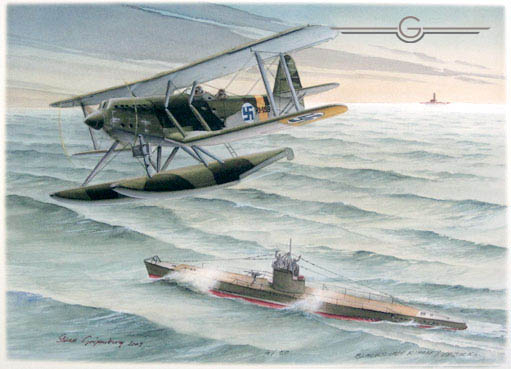
An Ilmavoimat Blackburn Ripon depicted here with the Finnish submarine Vesikko on the surface of the Gulf of Finland. In the background is the Bengtskärlighthouse. 50 numbered and signed prints were produced of this painting, signed by Snd.F. Saario (http://personal.eunet.fi/pp/gdes/gallery-e/)
We’ve looked at the Blackburn Ripon in an earlier post – at this stage, suffice it to say that the Ilmavoimat had ordered one Blackburn Ripon in 1929, at the same time acquiring an unlimited license for production. The Ilmavoimat then ordered a first production series of 15 Ripon IIFs (type R.29) from VL. Series I, consisting of 7 aircraft, was delivered to Merilentoasema between 17 Dec, 1930 and 20 Oct, 1931 (these were powered by the 480 hp Gnome Rhone Jupiter VI engine – this engine resulted in the plane being under-powered for float operations and beginning in 1933, attempts were made to find a more aoppropriate engine). Series II, consisting of 8 aircraft, was delivered between 20 Oct, 1931 and 18 Feb, 1932 (these were powered by the 535 hp Armstrong Siddeley Panther engines). VL had been busy manufacturing Haukka II Fighters from October 1928 to April 1930.
Manufacturing of the license-built Ripon’s commenced immediately after the Haukka’s had been completed and kept VL working at capacity through 1930 and 1931. Following the defense review of 1931, a third series of 25 Ripons was ordered in late 1931. These were delivered between 11 June, 1932 and 26 Oct, 1933 and were powered by the 580 hp Bristol Pegasus engines – an alternatiove sources says the 620hp Bristol Pegasus II engine), equipping the Ilmavoimat with two full squadrons (40 Ripons in all) which were all in service by early 1934. In total, 40 Ripons were produced under License. However, construction of the aircraft by VL was beset by several problems and there were cost increases and delays in the delivery of the aircraft. The original manufacturer was not able to supply the detailed plans within the agreed timefeame and VL’s factory did not have the necessary tools to build all the components. In the end some parts had to be ordered from England, which caused further delays.
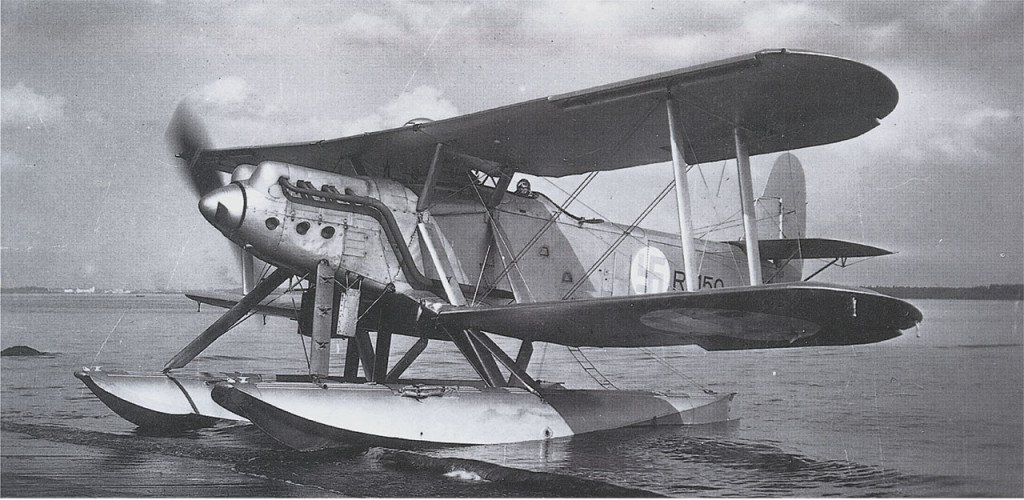
Quite a nice looking Finnish-built Blackburn Ripon with the Hispano Suiza V-12 photographed at Turkinsaari in the summer of 1937. This engine had 650 hp when the Bristol Pegasus II had 610 hp and the Armstrong Siddley Panther only 525 hp. The Finnish Air Force decided not to upgrade the engines and so this is the only Ripon to have an inline engine. Photo from “Suomen Ilmavoimat 1928-1940” by Keskinen, Partonen and Stenman
Letov S-18 (Smolik) Primary Trainers – 10 ordered 1930, 65 ordered early 1931
Through the 1930’s and the Second World War, the bulk of the Ilmavoimat’s Primary Trainers were the Letov S-18’s. This was a Czechoslovak single-engined two seat biplane trainer designed by Alois Smolík at the firm of Letov Kbely which first flew in 1925. In 1929, one Š-218 Smolik had been shown at the Helsinki International Show and was purchased outright in March 1930 An order for nine further aircraft together with the manufacturing license was soon placed with Czechoslovakia and the nine aircraft ordered from arrived at the Kauhava Aviation School over May-June, 1931.
In the meantime, the 1931 Military Review was well underway and with the planned expansion of the Ilmavoimat, it was decided that substantially increased numbers of Primary Trainers were required for Pilot Training. Almost immediately on plans for Air Force expansion having been formulated by mid-1931, an order was placed with the State Aircraft Factory for a further 65 Smolik Primary Trainers to be delivered over the period 1932-1933. An expansion to VL manufacturing capacity and numbers of employees was planned for and funded was provided in the 1931 defense budget to enable this and other future Ilmavoimat orders to be met in the planned timeframe. The aircraft were manufactured by VL and delivered over 1932 to 1934, remaining in use as basic trainers until 1945, proving to be effective in their role as Primary Trainers and having been used as the Primary Trainer for most of the Ilmavoimat Pilots who fought in the Winter War so effectively.
The construction of 65 of these aircraft over a three year period (1932 – 1933 – 1934), whilst also fulfilling the orders for the Blackburn Ripon together with a small number of other aircraft, was a major strain for the VL factory at Suomenlinna. Thus, with the VL factory heavily committed for the next two years of production, aircraft orders placed in the last quarter of 1931 were focused largely on the ordering of completed aircraft from foreign manufacturers. (Prior to this, a single order for 12 Fokker CV CV twin-seat light reconnaissance and bomber biplane aircraft had been placed on 17 March 19321 with Fokker. The Ilmavoimat had one already in servivce that been purchased in 1927 and this had proven reliable and effective in its role. It could be manufactured and supplied quickly from the Fokker plant in the Netherlands and delivery was indeed quick – all 13 were received in the winter of 1932. (as a footnote, during the Winter War, Sweden donated three more C.V-Es. The aircraft were used as reconnaissance and light bomber aircraft through until 1945. During the Winter War, the Finnish C.Vs flew extensively on reconnaissance and harassment bombing sorties without suffering any losses).
The 1931 Ilmavoimat Purchase Program
For late 1931, the purchase program focused on two different aircraft types. The first order that was placed was for six VL-designed E.30 Kotka (Eagle) maritime patrol aircraft.The existing Hansa floatplanes were both obsolete and worn out and with delays in the Ripon manufacturing program and an interim replacement was desperately needed. The purchasing of a small number of Kotka’s was an interim solution – further orders were not envisaged. The second order placed was for 20 Curtiss F8C-5 Helldiver Divebombers. Additional Fokker CV aircraft were also purchased.
Ilmavoimat Fokker CV
One Fokker C.V-E had been purchased in 1927, with delivery on 20 September of the same year. A further 13 were purchased on 17 March 1931, arriving in the winter of 1932. The Fokker C.V (or C.5) was the most successful export product of the Fokker factories after WWI. It was sold to Italy, Norway, Denmark, Hungary, Bolivia, China, Finland, Japan, Russia and the US. The C.V was fitted with twin FN 7.9 mm synchronized machineguns and one manually operated Lewis 7.9 mm machinegun in the rear which was operated by the navigator/observer/bomb-aimer. The two-seater plane was also capable of delivering a modest pay-load to the battlefield. For this purpose two racks were installed under the wings, which could carry either 16 shrapnel bombs of 8 kg each, 4 x 25 kg or 4 x 50 kg. With a speed of 155mph and a range of 621 miles, it was able to survive in WW2 combat by staying low and hedge-hopping.
Ilmavoimat VL Kotka I and II – 6 ordered 1931, retired 1944
The VL E.30 Kotka (Eagle) was a Finnish-designed and built two-seat biplane maritime patrol aircraft, designed by Kurt Berger at the State Aircraft Factory (Valtion Lentokonetehdas – VL). The project started when the Ilmavoimat began to look for a replacement for the now worn out and obsolete Hansa floatplanes that were in service with the Ilmavoimat. The prototype made its first flight on September 30, 1930. Work was terminated, only to be resumed and then continued in haste when the costs of, and delays in, the deliveries of the Blackburn Ripon became apparent. In 1931 Valtion Lentokonetehdas began producing a series of five aircraft. These were used as liaison aircraft until 1944.
The Kotka met the standards for a successful military aircraft at the time the order was placed and was no better or worse than comparable aircraft from other countries – which only shows that the amount of expertise was no better or worse than in other countries. The Ilmavoimat operated the six aircraft from 1931 to 1944. Additional numbers were contemplated but after the Ripon construction project was brought back onto track through the personal involvement of Rudolph Walden in the reorganization of the State Aircraft Factory (Valtion Lentokonetehdas – VL) it was decided that the aircraft was not required in any greater numbers.
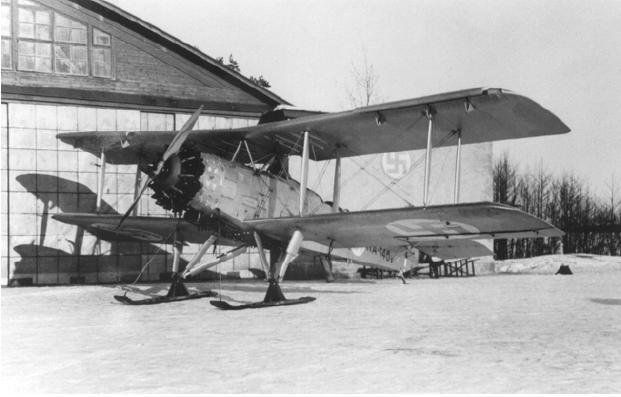
With a crew of 2 (Pilot and Observer), powered by a single Wright R-1820 Cyclone E radial engine, the Kotka had a maximum speed of 140mph and a service ceiling of 9.840 feet
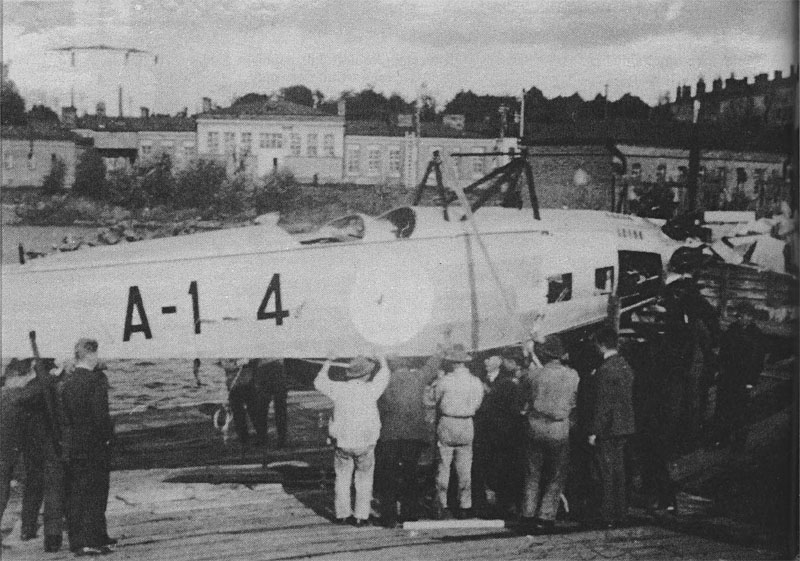
A VL Kotka II (Eagle) being assembled outdoors at Suomenlinna (a 250-year-old fortress outside Finland’s capital, Helsinki). VL had begun its production at Suomenlinna and Santahamina in Helsinki and the factory did not have an airport, only the sea and sea ice could be used for take-off and landing. Most of the aircraft built in Helsinki were seaplanes and because of the small size of the factory at Suomenlinna, much of the final assembly was done outdoors.
OTL Note: One aircraft (no. 4, KA-147) is still preserved and on display at the Päijät-Häme Aviation Museum.
Ilmavoimat Curtiss F8C-5 Hell-Diver Divebomber – 20 ordered in late 1931
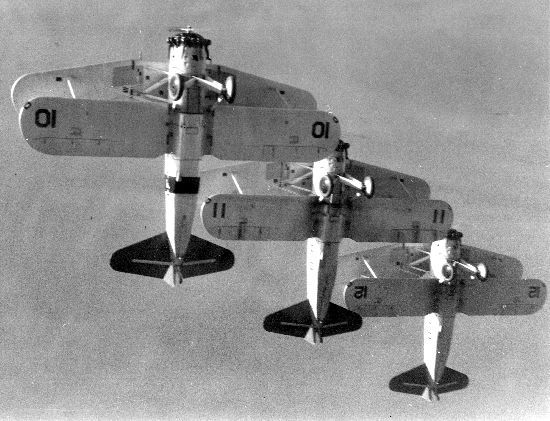
Ilmavoimat F8C-5 Helldivers after delivery but before being repainted in Ilmavoimat colours or insignia
The second and final purchase of the last quarter of 1931 was an aircraft near and dear to the heart of the commander of the Ilmavoimat. Somersalo had been a long-time advocate of aircraft in specialised roles. While continually ushing for a strong fighter force for the Ilmavoimat, he in no way neglected other types, and with the increased budget available in the last quarter of 1931 for aircraft purchases, he saw the way open to beginning to modernise and build up the ground-attack component of the Ilmavoimat. From 1919 on, this had been largely the role of the six now antiquated Junkers J1’s which Somersalo had ensured were kept in service to preserve the limited institutional ground-attack aircraft knowledge, experience and tactical doctrine. While the J1’s were by 1931 obsolete, they had at least allowed for the continuation of limited ground-attack training and participation in Army exercises in a ground-attack role. In searching for an immediate replacement, Somersalo settled on the purchase of a number of Curtiss F8C-4 Helldivers from the United States. This type had originated with the US Marine Corps who were, in the late 1920s, developing dive-bombing techniques – a development which Somersalo and others in the Ilmavoimat had followed with interest from the sparse and sporadic reports available. Immediately after having been given the go-ahead for the 1931 last-quarter purchase program, Somersalo together with one test pilot, two crews from the J1 Flight and a Valtion Lentokonetehdas representative embarked on a trip to the United States to evaluate the aircraft. The aircraft proved to be almost everything Somersalo was looking for and the J1 crews were also enthusiastic after a series of comprehensive test flights. The Valtion Lentokonetehdas representative was perhaps less enthusiastic as the Helldiver used a different construction method than those VL had experience working with.
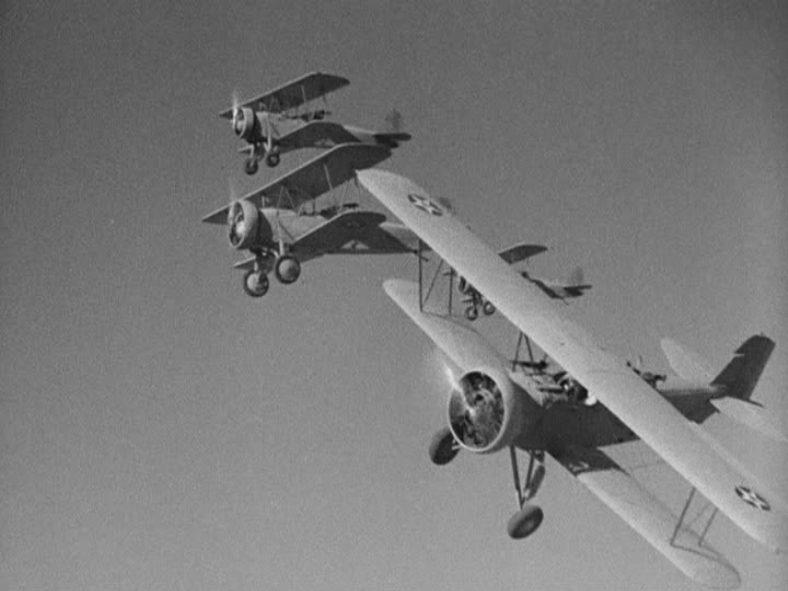
Curtiss F8C Helldiver’s peeling off……. With a top speed of 160mph, a range of 720 miles, a service ceiling of 16,250 feet and armed with two forward-firing machineguns and 500lbs of bombs, this was an effective dive-bomber of the early 1930’s. Performance-wise, the F8C Helldiver was as fast as any Fighter aircraft in service at the time it was purchased.
At its conception, Curtiss engineers had decided to make the Helldiver frame from welded steel tubing, which was a sharp departure over previous construction methods. Unlike the frame however, the Helldiver’s wing structure was a conventional of a wood-framework covered in canvas. Powered by a 450hp R-1340-80 Wasp, the XF8C-2 prototype had appeared early in 1929. Although the first prototype crashed in testing, the biplane showed enough promise to warrant further development. A second prototype, the XF8C-4, was flown in August 1929 and by early 1929, the Helldiver was in full production mode. The aircraft that emerged out of the ashes of the prototype was much more advanced. The F8C-4/02C Helldiver was now a pure, dedicated dive bomber aircraft with two fixed, forward firing heavy machine guns housed on the upper wing structure and a special bomb rack that was able to carry up to 500 pounds of ordinance.
The rack was designed to deploy the bomb away from the aircraft as it dived in order to avoid the bomb entering the propeller arc. As with many planes of the era, the F8C, although a very robust platform still lacked self-sealing fuel tanks which could have proved to be fatal if the plane were involved in combat. A single bullet could have turned the aircraft into a fiery coffin. Twenty five of the first Helldiver model, the F8C-4, went on to serve aboard the US Navy’s infant aircraft carrier fleet. The US Marine Corps received 63 examples of the modified, land based F8C-5 version. A 3rd type, a pure reconnaissance airplane, was known as the 02C-1. Thirty examples of this version were also ordered by the Navy. Although the aircraft did not see full fledged combat operations with the US Navy or Marine Corps, it had its moment in the sun. The plane, a favorite of the Navy’s nascent public relation office, was immortalized as the aircraft that shot down King Kong as he sat on top of the Empire State Building during the famous 1930s film.
Based on the success of the test flights, Somersalo signed an order with Curtiss on behalf of the Ilmavoimat for 20 F8C-5 Helldivers in late 1931. These were delivered to Finland in one shipment, arriving in June 1932 and entering service shortly thereafter. A two-seater, the Helldiver typically carried a Pilot in the front seat and an Observer in the rear. The Ilmavoimat version was fitted with then new 712 hp (531 kW) Wright Cyclone SR-1820 Cyclone 9 radial piston engine (giving a substantial improvement in performance over earlier models) and an additional ring-mounted machinegun for the Observer / Radio Operator. A small team from Curtiss accompanied the shipment, assisted with assembly and undertook a training program for Valtion Lentokonetehdas technical personnel and for the Ilmavoimat ground crew responsible for maintaining the aircraft. While on his trip to the USA and immediately after signing the order, Somersalo had arranged (with the prior concurrence of Finlands Ministry of Defence) for four US Marine Corps personnel (2 Pilots and 2 Observers) to spend some months with the Ilmavoimat Squadron flying the Helldivers, familiarising Ilmavoimat personnel with the aircraft and training them in the dive-bombing techniques that had been developed by the US Navy and Marine Corps. It was a valuable learning experience and a capability that the Ilmavoimat would go on to build on independantly.
Once familiar with the aircraft and the techniques of dive bombing, the Helldiver Squadron went on to develop standard dive bombing procedures over 1933. Having developed a standard dive bombing procedure, the Helldiver Squadron commenced regular Army cooperation exercises from 1934 on. From 1935 on, the Squadron also exercised regularly with the Experimental Combined Arms Battle Group, where the skills and lessons learned were incorporated into the military tactical battle fighting doctrine that was in the process of being developed and implemented in a continuous feedback loop. It was as a result of the lessons learned from these ongoing exercises that the Ilmavoimat purchased additional and more modern dive bombers in the period preceding the Winter War. These would serve Finland well in battle, but it was the purchase of the Helldivers that laid the foundations for future success.
The 1932 Ilmavoimat Purchase Program
In late 1931, the Ilmavoimat and Valtion Lentokonetehdas put in place a joint Procurement Organisation structured to continually tracking and evaluating aircraft from manufacturers in Britain, France, Italy, Germany, Czechoslovakia, Poland and the United States. Where an aircraft was of interest and available for test flights, a small evaluation team was sent to the manufacturer to carry out a preliminary evaluation program. At the same time, a separate unit within the General Staff (with Ilmavoimat and Valtion Lentokonetehdas members as well as Maavoimat, Merivoimat and technical / civilian members) was setup to track weapons development programs of the primary threat – the USSR. Attention was also paid to doctrinal development and, wherever possible (and this was rare), Finnish military representatives attended Soviet military exercises as observers. In addition, close ties were maintained with the German military and important information on the Soviet Union was obtained unofficially (and at times officially) through this channel.
In 1932, the Ilmavoimat commenced upgrading its Fighter Aircraft. While longer term plans were still being made, it was decided that at least two Squadrons of the most modern fighters should be purchased as a start and to enable the Fighter Pilot training and development program to move ahead. To this end, the Ilmavoimat decided on the purchase of forty Bristol Bulldog’s from the UK.
Bristol Bulldog Biplane Fighter – ordered 1932
The Bristol Bulldog was a British Royal Air Force (RAF) single-seat biplane fighter designed during the late 1920s by the Bristol Aeroplane Company. The Ilmavoimat purchased forty Bristol Bulldog Mk IVAs from Britain, ordering these on 24 March 1932 and taking delivery in February 1933. This was a relatively expensive purchase but by purchasing the aircraft outright rather than building under license, rapid delivery was assured.
In September 1926, the British Air Ministry had stated a need for a single-seat fighter capable of operating in day and night-time conditions; to be armed with two 0.303 in (7.7 mm) Vickers machine guns and to be powered by a radial air-cooled engine. This requirement was laid down in Specification F9/26. The Bulldog was designed by Frank Barnwell, the Chief Designer of the Bristol company, (who had served as a Captain in the British Army during the First World War), as a private venture to meet the requirements of this specification. The Bristol Bulldog was a mixed structure bi-plane fighter with a fixed landing gear. It had a high tensile steel strip construction with fabric skinning. By comparison with the standard Mk. IIA, the Mk. IVA had deeper, biconvex wing sections, permitting the fuel tanks to be accommodated completely within the wing profile; reduced lower wing chord to improve the pilot’s view; single (in place of double) lift wires; a deeper rear fuselage of increased stiffness and a long-chord cowling for the engine.
The prototype Bulldog, the Bulldog Mk. I first flew on 17 May 1927. After initial consideration of all the types entered to meet the specification, the Bulldog and the Hawker Hawfinch were selected by the British Air Ministry for more detailed evaluation. While the Bulldog’s manoeuvrability and strength were praised by the RAF, it initially had poor spinning recovery properties and was therefore fitted with a lengthened rear fuselage. In this form, it was declared the winner of the competition, having slightly superior speed and being easier to maintain, requiring fewer changes to produce an operational aircraft than the Hawfinch. The full-production Bulldog came in the form of the Mk.II, which had a modified structure but in every other respect was identical to the original Bulldog; having two 0.303 in (7.7 mm) Vickers machine guns; a capacity for four 20 lb (9 kg) bombs; a 450 hp (336 kW) Bristol Jupiter radial engine; giving the Bulldog a maximum speed of just under 180 mph (290 km/h) and a range of 300 miles (480 km).
The aircraft entered production in 1928, entering service the following year, and becoming, during the early 1930s, the most widely used aircraft in the RAF over the inter-war period with over four hundred Bulldogs produced. It was cheap to maintain and thus, at a time of defence budget constraints, was the more preferable option to any other of the more expensive competitors. The Mk. IIA was again virtually similar to its predecessor, though it had a new Jupiter engine and a strengthened structure. The Bulldog proved to be quite a successful export to foreign air forces, seeing service with Australia, Denmark, Estonia, Finland, Japan, Latvia, Siam, Spain and Sweden. The Bulldog was withdrawn from RAF service in 1937, being replaced by the Hawker Hurricane and Supermarine Spitfire, both of which would become legends of the RAF for their contributions during the Second World War. The Bristol Bulldog’s career was not over though, for the type continued to serve with other air forces. The Bulldog never saw combat service with the RAF. A number of Bulldogs, ex-Latvian aircraft, saw service during the Spanish Civil War, as part of the forces fighting the Nationalists.
Ilmavoimat Bulldogs however saw combat in two wars. In 1937, twenty Bulldogs were sold as “surplus” to a German arms dealer, and “somehow” found their way to Spain, where by a strange coincidence they were the first aircraft flown by the Finnish Volunteer Squadron attached to the Finnish Volunteer Division (“Pohjan Pojat” – the Boys from the North) fighting with Franco’s Nationalist Forces in the Spanish Civil War. Considerable experience was gained, with the Finnish Pilots achieving rermarkable successes in their Bulldogs against their “Republican” opponents. This experience will be discussed in detail in a later post covering all aspects of the now little-known and virtually forgotten Finnish Volunteer involvement in the Spanish Civil War.
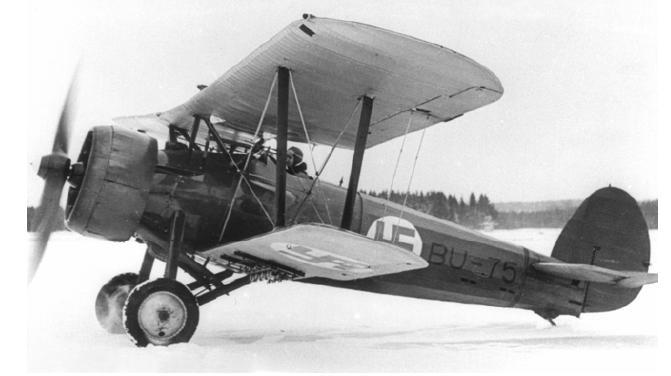
The Bulldog was the first aircraft to exceed 300 km/h in level flight in Finland. Sweden donated two Bulldog IIAs to Finland during the Winter War. These aircraft had negligible effect on the war effort due to damage they sustained in service.
Ilmavoimat Bulldogs continued to serve during the Winter War against the Soviet Union, which began in 1939. As in Spain, the Bulldogs fought well against their Soviet opponent, gaining six kills by five pilots for the loss of one of their own, the types shot down being two Polikarpov I-16s and four Tupolev SB-2s, both of which were quite superior in terms of technology compared to the Bulldog. In fact, OTL, the very first aerial victory of the Finnish Air Force was achieved by a Bulldog piloted by SSgt Toivo Uuttu on 1 December 1939. OTL, the Bulldog continued in service during the subsequent Continuation War against the Soviet Union, though without scoring any further kills or suffering losses. ATL, the Bulldog was generally relegated to use as an Advanced Fighter Trainer and, while it saw limited action in early stages of the Winter War, was relegated to training use from early 1940.
1933 Ilmavoimat Organisational Changes
By 1933, the Ilmavoimat’s five-year plan had been drawn up and approved. In essence, this consisted of a steady acquisiton program for a combination of Fighters, Ground-attack aircraft and bombers, maritime patrol, transport and trainers. In addition, the ongoing role of dive-bombers was seen as being applicable to supporting both the Maavoimat and Merivoimat. The intent was to ensure the continual phasing in of late-model aircraft on an ongoing basis. That this would in all likeliehood result in a disparate range of aircraft in service at any one time was recognised. Conversely, this would also reduce the chances of entering a war with a large number of aircraft that were obsolete and not capable of putting up an effective fight. Some aircraft would be obsolete or outclassed, but at least some would not. With this in mind, actual purchases were decided on a year-by-year basis dependent on what was available and the conclusions of the evaluation and test teams.
At the same time, it was also recognised that the ongoing expansion of the Ilmavoimat would demand more personnel and infrastructure. Up until 1932, the Ilmavoimat had generally been made up largely of permanent personnel with small numbers of reservists. From 1933 on, the Ilmavoimat would be gradually re-shaped, with the organisation being structured around a core of permanent personnel forming a small number of squadrons together with permanent training cadre, conscript-volunteers and Active Reserves. A precondition of conscripts being accepted as volunteers for the Ilmavoimat would be a commitment to 18 months of conscript service rather than the Maavoimat’s 12 months, joining the Ilmavoimat Active Reserve for a ten-year period and maintaining annual training status. With the growth that was projected for the Ilmavoimat between 1933 and 1938, over time it was foreseen that the bulk of the Ilmavoimat squadrons would be manned by Active Reserve units, with an increasingly active weekend training schedule needed to keep training and skills current.
Additionally, and far more radically, the Ilmavoimat from 1933 on permitted women to join in all capacities, including as pilots (albeit women pilots were permitted to fly transport aircraft and ferry-flights only – and had to have alrerady qualified as civilian pilots before being accepted to sit the entrance exams). While joining was voluntary for women, after being accepted they were then subject to the same training as male conscripts. This became an increasingly popular choice for young women and by the late 1930’s, approximately one third of Ilmavoimat personnel were women, serving in all except front-line pilot and air-crew roles and filling many of the maintenance and administrative positions within the Ilmavoimat, as well as crewing the AA Guns protecting Ilmavoimat airbases, working as parachute-packers, bomb-fitters and the like.
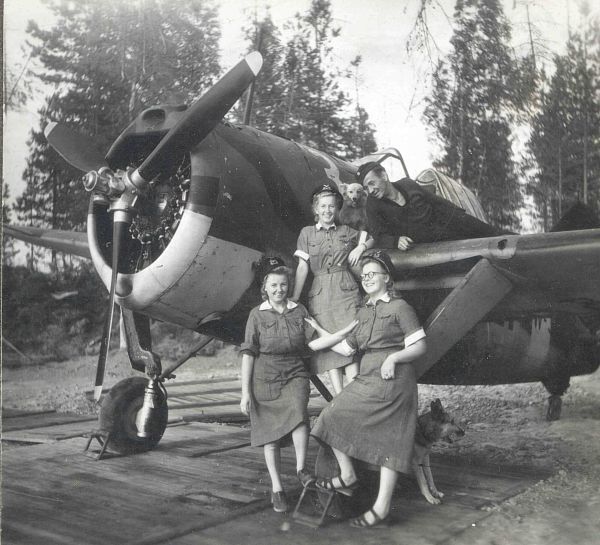
Ilmavoimat Lotta ground-crew personnel in Summer 1940 with the Fighter they were responsible for maintaining. Ilmavoimat-Lotta ground-crew dress was usually not this formal, and in general clothing was identical to that issued to male groundcrew. It is likely that these Lottas were “dressed for the photograph.”
With the projected growth, the Ilmavoimat also focused more on developing an interest in aviation at an early age and providing as much preliminary training as possible. To this end, the existing Suomen Ilmapuolustusliitto or SIPL (Air Defence League) was given more support and the Ilmavoimat also encouraged gliding clubs and civilian flying, allowing Ilmavoimat bases to be used for these purposes.
The Suomen Ilmapuolustusliitto or SIPL (Air Defence League)
Gliding and private flying in Finland was closely associated with the Suomen Ilmapuolustusliitto (or SIPL as it was usually abbreviated to). SIPL had been founded in the 1920s as a kind of Air Civil Guard with local associations (Ilmapuolustusyhdistys) which owned their own aircraft and trained pilots. In the nationalist mood of the day, the task of Suomen Ilmapuolustusliitto was seen as being to arouse the interest of youth in aviation in the spirit of building up the national defences. The building of flying models and glider flying training were arranged for youngsters. (If you recall, the designer of the Merivoimat ground-effect craft we looked at previously, Toivo Kaario, had his interest in aviation aroused and encouraged in just this manner).
From 1933 on, the Ilmavoimat provided primary training aircraft and instructors to SIPL, with actual flying courses for older youth arranged. The purpose of these courses was to give basic training to to future air force pilots and at the same time, assess suitability for potential pilot trainees. The applicants had to fullfil Ilmavoimat requirements and to commit to finish an Imavoimat officer course if accepted. The aim was to train reserve pilots and funding was provided from the Ministry of Defence, with flying training provided primarily by Ilmavoimat Officers. But flying was not the only activity carried out by SIPL. Aircraft engineering and mechanics were taught, as was radio communications and training was open to both boys and girls. Many of the Ilmavoimat ground-crew and support personnel in the Winter War had their early interest in the Ilmavoimat encouraged by SIPL in the pre-war years and it was a program that paid remarkable dividends. The program grew in popularity and by 1938, the Ilmavoimat loaned fifteen Smolik trainers to SIPL for their annual Summer Camp training exercises, as well as regularly providing training aircraft on weekends.
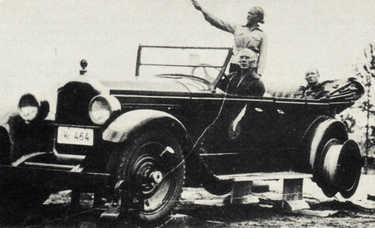
Jamilla: Photo taken in 1937. Miss Aili Heikinaro, christened “Finnish die Hannaksikin” stands in the new winch-Packard holding an outstretched signal flag. She was the first female glider pilot in the country. In the driver’s seat sits Vaasa Glider Club President Gustav Aulin and in the backseat is “Pasi” Jääskeläinen. Note the “guillotine” on the left front wheel.
Simultaneously with interest in SIPL, Gliding Clubs grew in popularity through the 1930s – and proved to be an activity with an unexpected outcome in the Winter War. Gliding as an activity in Finland began in the 1920s, but it was in the 1930s that it really took off. A demonstration of glising in Finland in 1934 by the German Deutscher Luftsportsvereinin gained a great deal of press attention and helped to popularise the sport and on 17 July 1935 the Jämi Gliding School held its first course. These gliding courses were open only to members of SIPL and as they grew in popularity and other Gliding Schools were opened, SIPL began providing its affiliated associations with free glider kits (in fact, in 1936 SIPL established Jämijärvi Wood and Metal Ltd to manufacture Gliders for the rapidly gowing gliding clubs. As we will see in a later post, Jämijärvi Wood and Metal Ltd took on a military role in the late 1930’s as the then newly-established Maavoimat Para-Jaeger units experimented with the use of assault-gliders).Initially, Glider flying was organized on the German model – with Gliders launched from the tops of small hills and with flight duration measured in seconds or tens of seconds. With gliders being single seaters, the pilots first flight was a solo flight – which generally (but not always….) resulted in increased confidence. Typical of these Gliding Clubs was the Vaas Gliding Club, which was founded in the mid-1930s (and continues to this day incidentally). The Vaasa Gliding Club acquired its first Winch Car, a Packard, in December 1936. The Packard was an open top car, with one rear wheel replaced with a cable-drum and a “guillotine” fitted on the left front wheel to cut the rope used for towing if necessary. (The Packard was lost during the war).
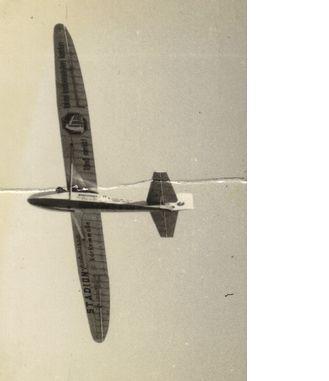
An old photo of “Antti-Jukasta” from the 1930s, complete with advertising for a brewery – “the mark which guarantees the quality of the drink.” On the wings “Stadion pukimissa lentämällä pisimmälle ja korkeimmalle” and “Tämä merkki takaa kudonnaisten laadun”
The development of Gliding proceeded at a rapid paceover 1934-1935 and in 1936, the Club’s first “real” glider, the Grunau Baby IIa was built. This was one of the most famous glider models of the 1930s and was built in large numbers around the world, with some 6,000 constructed worldwide. In Finland, over 30 of the Grunau Baby’s were built. Construction of the first Finnish Grunau Baby Iia started in Vaasa in December 1935, with SIPL organising and paying for all the necessary building materials as well as an Office Administrator to support the work. Volunteers from the Vaasa Club built the Glider which was completed on 27 June 1936 and christened “Antti-Jukaksi,” which also became the symbol of the OH-Anssi-Jukka. Later, the machine was painted with the symbol of OH-VASA 3.
In addition to the Vaasa Grunau Baby, further “Baby’s” wete built in Turku, Kuopio, Lahti, and two planes in Helsinki. The Vaasa Grunau Baby was taken to Jämijärvi in the same summer that it was built and started flights there. The machine participated the same year in Air Shows at Turku (6 September), Vyborg (13 September) and in Utti (20 September). Lieutenant T B Nissinen from Viipuri demonstrated aerobatics and Miss Aili Heikinaro was christened the “Finnish Hannaksi Die” by the public after a film of the flights was screened.
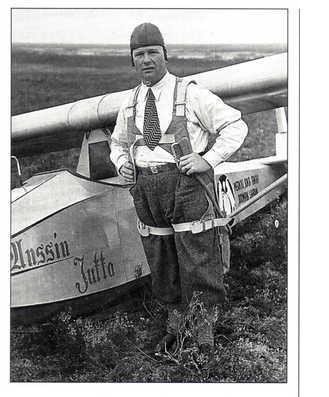
Jämi Instructor and Ilmavoimat Reserve Lieutenant T B Nissinen demonstrates the Vaasa clubs “Anssi-Jukka” Grunau Baby glider in the the 1930’s.
Reserve Lieutenant T B Nissinen had started his career as a pilot in Utti in 1924 and flew Maritime Patrol aircraft. He was based from Vaasa from 1932 and in addition to flying for the Ilmavoimat, Lt. Nissinen was involved from the outset in training and supervising flying and glider pilot training at Vaasa. SIPL hired Nissinen as a glider flight instructor in 1935, when his career with the Ilmavoimat ended. In the same year he became acquainted with German Gliding through the award of a German Ministry of Aviation scholarship.
He served as director of construction union training courses in 1936-37, when Finland built a large number of Grunau 9 and Grunau Baby machines. Lt. Nissinen was awarded the title “flight captain” and the prestigious Harmon Award for Gliding Development in 1938. Flight Captain Nissinen was director of the Vaasa Gliding Club from 1935-44, and contributed much to the development of Finnish Gliding during that time. After his flying career ended, T.B. Nissinen took the position of Headmaster of the Kymi Oy Högfors engineering school.
That gliding was popular and that these Air Shows were well attended by the public is illustrated in this Post, which is a translation of an Article from the North Satakunta Journal of 15 August 1936 and a series of accompanying photos…..
Return to Table of Contents for “Punainen myrsky – valkoinen kuolema” (Red Storm, White Death)
 Copyright secured by Digiprove © 2013 Alternative Finland
Copyright secured by Digiprove © 2013 Alternative Finland


